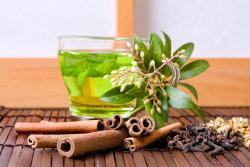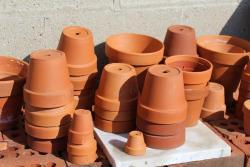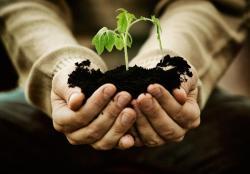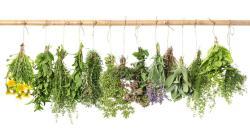
Even if you have very little gardening experience or very little space to work with, you can still create a successful herb garden in your home. Herbs are some of the easiest plants to grow and maintain – no green thumb is necessary. Rather than going out to the grocery store, you will be able to snip your herbs right out of the container in your home, preferably your kitchen. This saves you time, saves you money, and gives you the freshest possible herbs to use in your recipes!
How To Get Started

Before planting any herbs, you need to know which herbs you want to grow. Many popular herbs grow very well indoors, such as basil, chives, dill, lemon balm, oregano, and thyme. It's a wonderful thing having the herbs you love most right where you need them when it's time to use them. All you have to do is clip a few leaves of oregano and crumble them into your spaghetti sauce or put some fresh chives from your garden into your baked potato.
After you've decided which herbs you're going to grow, the next thing is to locate where you're going to put them. Most herbs require at least 5 to 6 hours of direct sunlight every day, so you'll need a sunny window, preferably facing south. You'll get the best results if you can keep the temperature somewhere between 60 and 70°F. If that's cooler than you usually keep your home during the winter, the garage can also be a good fit for your indoor herb garden.
Choosing the Containers You're Going To Use

There's really no best container to use for growing indoor herbs. Terra-cotta planters are probably the most popular, but you don't have to use those. The important thing is that the pots you use must have a drainage hole at the bottom to let out excess water. You don't want the roots of your herbs to rot, and that's what will happen if the excess water does not drain from the pot. Be sure to put a saucer or similar container beneath the pot in order to catch that extra water when it does run out.
If you don't have a lot of space to work with, it's fine to plant different kinds of herbs in the same container. You want to space them out enough so their roots have room to grow, but they otherwise should not interfere with each other.
Choosing the Soil You're Going To Use

I know it's tempting to put soil from the backyard into your containers because it's available and free, but that's usually not the best choice for growing herbs indoors. The soil that's in your backyard is much more likely to dry out quickly when it's put into pots. That means you'll have to spend more time, effort, and water to keep your plants healthy.
Just as important, if not even more important, is that the soil found in your backyard might contain diseases that could damage or even kill your plants. So, unless you happen to know that the dirt from your yard is good loam, and you don't mind doing the extra watering, you're really better off purchasing potting soil from a garden center.
The experts working at the garden center can help you choose the soil that's best for the herbs you want to grow. Just be sure to tell them that your garden is a container garden that you're growing indoors and they'll get you the right mix.
Planting the Seeds in Your New Garden

When you initially plant the seeds for your herbs, you don't want to plant them in the big containers. Rather, you should plant the seeds in peat pots. Most planters are just too big for the seeds at first.
Fill the peat pots with the potting soil that you got, and put the pot into a small bowl of water. Let the peat pot completely absorb all of the water. Then bury the seeds to a shallow depth that's about three or maybe four times the diameter of the seeds.
When growing the seeds, only put the same kind of seed into each peat pot. After they've been planted, cover those pots with a plastic bag to create your own miniature greenhouse. Once the seeds have sprouted, you can move the entire peat pot into the big planter. At that point it's fine to put different kinds of herbs into the same container.
When moving those seedlings into the larger pots, add 2 to 3 inches of soil into the container first. Then place the seedling into the pot. After that, fill the rest of the pot was soil, leaving about an inch of space so that there is enough room to water the plant without it overflowing. Finally, push firmly on the soil around the plants, being careful not to push on the plant itself.
Tips for Making Your New Herb Garden a Success

Novice gardeners are often inclined to water the plants far too much. Don't make that mistake! Too much water in the pot can cause the roots to rot, so make sure that you water enough to keep the soil moist, but don't flood the containers.
Just as watering too much can kill your plants, using too much fertilizer can hurt them as well. Don't overdo it, however inclined you are to feed those baby herbs. Adding fertilizer, preferably organic fertilizer, once a month is usually plenty.
It's safe to start clipping leaves from the herbs when they reach 6 to 8 inches tall. Just be sure not to take off more than one quarter of the plant at any given time, and be sure to let that plant grow back to its previous height before you clip off any more. If there is an herb that you love to use all the time, just make sure that you have multiple plants in your garden so you'll always have plenty.
Live in a shady area that doesn't get enough sun? That's not a problem. You can use grow lights to supplement whatever sunlight is available where you live.
Make sure that those herbs have enough space and aren't too crowded in the containers. Also, make sure you don't put the plants near any of the vents in your house. Herbs don't grow well if they're too constricted or have large temperature fluctuations throughout the day.
Herb-Specific Tips

Basil is fun and easy to grow in your garden, but it requires a lot of bright light and nice warm temperatures.
Chives, which are in the onion family, also love bright light but prefer cooler temperatures.
Dill plants can grow very large, getting up to 4 feet in height. That's usually too large for an indoor garden, so be sure to buy a dwarf variety to save some of that space. Also, dill will not grow back after it's been harvested, so if you want to add this herb to your garden, you're going to have to keep replanting after use.
Like basil, lemon balm is easy to grow. It also has a wonderful fragrance that works great in salads and drinks.
Thyme, a very popular herb, is a little different from the others. When planting the seeds, you only want to cover them lightly with soil – or not cover them at all. Also, be sure to keep these plants moist until they're growing strong.
About the Author
Jonathan Leger is a gardening enthusiast and a member of the Garden Writer's Association. He runs a small site on the history, education and care of a variety of roses at CabbageRoses.net
| Thread Title | Last Reply | Replies |
|---|---|---|
| Other winter herbs by DonShirer | Mar 6, 2018 4:22 PM | 1 |